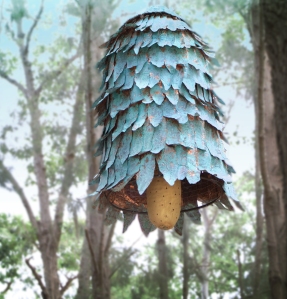Three Native “Bee Bells” made by Ana Pollak & myself with community participation were launched as a part of Pollinator Week 2016.
The following is the speech I gave at the launch at Picton Botanic Gardens on November 22nd. Photos by Steve Fearnley.
As we know, pollination has helped shaped diversity on Earth. Without bees the multitude of flowering plants and fruits would not exist. Understanding that simple symbiotic connection- Bees=Pollination=Food – is what pollinator week is all about. This “Bee Aware” project is unique in that it has synthesised environmental education with hands-on, thought provoking art making. In so doing, the project has increased awareness of the vital role Native Australian Solitary bees perform, in a world where human activity continues to tip the natural scales out of balance.

This project has seen Ana Pollak and myself guiding community members in the creation of three “Bee Bells”. Each of the works provides a different type of habitat for Australian solitary bees that we know are already present in the area. The copper clad bee bell, with it’s clay cob substrate, provides habitat for Resin Bees, Blue Banded bees and Teddy Bear Bees. Of the two terracotta bee bells, one provides a bamboo substrate – habitat for Leaf cutters, Reed bees and Masked bees- and a Xanthorrea or Grass Tree Substrate, which we hope will attract Carpenter Bees.

These intriguing sculptural forms will provide habitat for native solitary bees whilst becoming a focal point which we hope will provoke questions, an impetus for visitors to the gardens to learn more about the important pollination role our native bees perform.
The inspiration for the forms is distinctly “Japanesque” . The Japanese Shinto philosophy venerates the inherent spirit in all nature, whether animate or inanimate. As bees offer a clear example of the symbiotic interconnectedness of all things, it’s no wonder that Bee Shrines – hives that are roofed with ornate Japanese tiles- are present in some Japanese Shinto Temples.
These Bee Bells combine a Japanese aesthetic with observation of the habits of native Australian Leaf cutter bees. Most people have seen leaves in their gardens with almost perfect circles cut out from the edges of the leaves. That’s the work of Leaf cutter bees, who then use the circlets of leaf to line their nesting tubes and to cap off their pupal chambers. In this project, the participants assumed the role of the leaf cutter bees, shaping leaves in copper and terracotta to clad each of the nesting substrates.


Ana and I have very much enjoyed working together on this project, guided by inspirational environmental educator, entomologist Megan Halcroft. It’s been a great pleasure to see our ideas being shaped by members of the Wollondilly community, and very satisfying to see the works hanging gracefully within this
Casuarina grove. Thank you so much to Susan Conroy and team at Southern Tablelands Arts and to Rob Moran, at Wollondilly Shire Council , for making this project possible. A huge thanks to Podge head gardener at Picton Botanic Gardens, for his enthusiasm, thoughtfulness and hard work getting these sculptural habitats off the ground, and thanks also to Rach, his apprentice. Many thanks as well to the community members who took part in this project- these works belong to this community space because of you. Please share your experience of making them with others.
